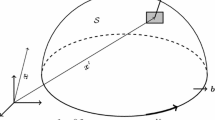This contribution overviews the premise and the promise of Dislocation Dynamics (DD) as a method for direct calculation of plasticity and strength of single crystals from the underlying motion of dislocation lines. First, a few aspects of dislocation physics more relevant for the DD method development will be discussed followed by a brief introduction of several key algorithmic and numerical aspects of the DD method. Then, specific examples of applications of the DD method will be given to illustrate the method’s ability to capture the essential physics of collective dislocation motion. The primary focus will be on BCC metals where several key results have recently emerged from DD simulations. Finally, the method’s applicability to simulations of irradiated metals and alloys will be discussed along with the associated method development issues.
Access this chapter
Tax calculation will be finalised at checkout
Purchases are for personal use only
Preview
Unable to display preview. Download preview PDF.
Similar content being viewed by others
References
Taylor, G. I., 1934, Plastic deformation of crystals. Proceedings of the Royal Society of London 145:362-404.
Polanyi, M., 1934, Lattice distortion which originates plastic flow. Z. Phys. 89(9-10): 660-662.
Orowan, E., 1934, Plasticity of crystals. Z. Phys. 89(9-10):605-659.
Hirsch, P. B., Horne, R. W., and Whelan, M. J., 1956, Direct observations of the arrangement and motion of dislocations in aluminium. Phil. Mag., 1(7):677-684.
Cai, W., Bulatov, V. V., Chang, J., Li, J., and Yip, S., 2004, Dislocation core effects on mobility in: Dislocations in Solids, F. R. N. Nabarro and J. P. Hirth, North-Holland, 12:1-117.
Bulatov, V. V., and Cai. W., 2006, Line Dislocation Dynamics in: Computer Simulations of Dislocations, Oxford University Press, pp 196-240.
Arsenlis, A., Cai, W., Tang, M., et al., 2007, Enabling strain hardening simulations with dislocation dynamics, Model. Simul. Mat. Sci. Eng. 15:553-595.
Bulatov, V. V., Hsiung, L. L., Tang, M., et al., 2006, Dislocation multi-junctions and strain hardening, Nature 440:1174-1178.
Author information
Authors and Affiliations
Editor information
Editors and Affiliations
Rights and permissions
Copyright information
© 2008 Springer Science + Business Media B.V
About this paper
Cite this paper
Bulatov, V.V. (2008). Crystal Plasticity from Dislocation Dynamics. In: Ghetta, V., Gorse, D., Mazière, D., Pontikis, V. (eds) Materials Issues for Generation IV Systems. NATO Science for Peace and Security Series B: Physics and Biophysics. Springer, Dordrecht. https://doi.org/10.1007/978-1-4020-8422-5_14
Download citation
DOI: https://doi.org/10.1007/978-1-4020-8422-5_14
Publisher Name: Springer, Dordrecht
Print ISBN: 978-1-4020-8421-8
Online ISBN: 978-1-4020-8422-5
eBook Packages: Physics and AstronomyPhysics and Astronomy (R0)




